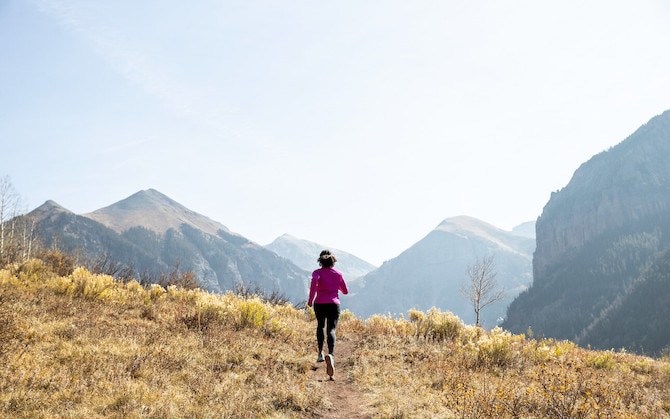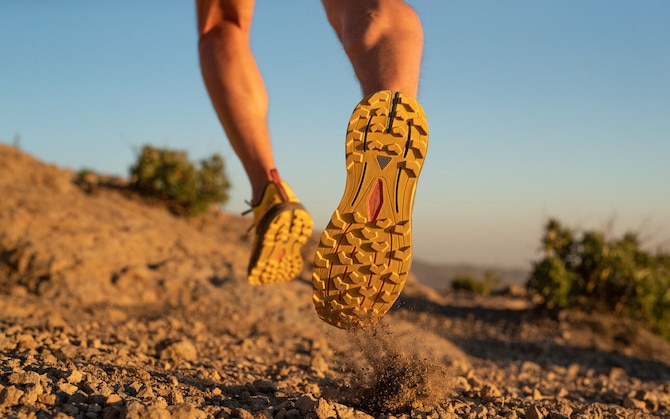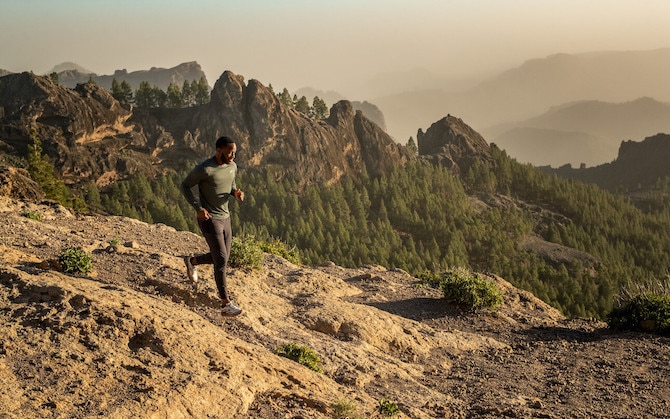6 tips to make the most of trail running

Trail running can be a rewarding experience for new and seasoned runners alike, as it can be the perfect way to break the monotony of running through your typical neighborhoods or on hard pavement. However, getting started takes some knowledge, especially considering there are risks involved. From avoiding injuries to picking the right shoes, here are six tips for transitioning from the streets to the trails.
1. Adjust your cadence to the terrain
Doug Horton, a kinesiology professor and runner, leads a weekly trail running meetup. He explains that minding your cadence and stride is important when running on trails. "It requires a different cadence than road running," he says. "Embrace the changing terrain using short steps, longer strides, side-to-side hops, and explode up hills. If you are comfortable on downhills, open it up and let it fly."
Also, while you may be someone who never walks during a race, know that this is sometimes safer than running across slippery rocks or roots. Slipping and sliding aside, you may also be dealing with elevation changes. After running to the tip of a steep path, a walking recovery may be best. Some races pride themselves on challenging you both mentally and physically, so don't add more pressure by insisting you'll run every rocky, muddy inch.
Despite the need to run slower than usual, trail running is tough, and it really poses a challenge to stabilizing muscles like those in your core. You are still getting a workout, and just like road running, walking some is OK.
2. Be mindful of your surroundings
Nature is beautiful. And dangerous. Tree roots, rocks, and even wild animals could be hazardous. Runners may even find themselves dodging snakes and puddles that hide holes. This is a good reason to change your pace, as you're more likely to trip and fall if you're running at your normal pace with your normal stride.
Also, just like on the road, you need to be alert to everything going on around you. If you're running on the Wissahickon Trail in Philadelphia, you need to be able to hear "On your left!" or footsteps following you. If you are at Valles Caldera National Preserve, you may need to watch for bears or coyotes. If you have to run with music, invest in headphones that are not noise-canceling, and don't turn the music up too loud.

3. Buy the right shoes
Sneakers specifically made for trails will make for a safer, more pleasant run. A proper shoe can mean less pain after having your toes bang into rocks for hours. Typical features include waterproof materials, bumpy treads, and additional cushioning.
A waterproof shoe can mean an easier recovery after miles of trail running. That's because you can end up with fewer blisters after sloshing through the mud. A quality trail shoe also typically has cleats, or lugs, which allow you to run across rocks and roots without worrying about slipping. The extra traction also means you are using less energy and are less likely to be injured as you compensate for the sliding. The end result of these features is more confidence on your runs and a more enjoyable experience.
4. Run a familiar or well-marked route
Before conquering a new trail, familiarize yourself with the elevation and any quick turns. It's easy to get lost on a course, and unless you're running simply for pleasure, you may find yourself running more or less than you set out for. In that case, the GPS on your watch or phone can come in handy. Save a copy of your trail map to your phone so you can reserve the battery and still be able to find your way out of the woods.
5. Bring a friend
This isn't always feasible, and sometimes, the only running buddy available is your pup. However, if you intend to run an unpaved or less populated course, bringing a friend can keep you safe and even offer help in case of an accident. A buddy also cuts down on the need to listen to music.
If you do run with a friend or a group, Horton advises, "Give yourself some distance from the person in front of you so you have time to adjust your step."

6. Pack light, but pack well
Whatever can fit in your hydration vest or waist pouch may be enough to get you through a trail run. Make sure to have some sort of electrolytes to mix into your water or pop into your mouth if you begin to feel dehydrated. However, don't wait until you feel completely parched before you start refueling.
Horton offers this tip: "If you use a hydration pack, make sure you turn the pack upside down and suck the air out. This will compress the bladder and eliminate the loud sloshing sound from water moving around."
For more serious treks, a headlamp may be necessary for an overnight or early morning run. Some runners even encounter the occasional bridge or tunnel. Also, if you're going off the grid, consider carrying a purification tablet to clean any water if there is a chance you'll run out too soon.
A small charging pack can help too if you are afraid of your phone dying, and make sure it is at 100% before you leave. Spotty reception can drain your battery. Try your best to stay in airplane mode if you're in this type of area, and if possible, download music to your watch or phone, which can cut down on the amount of power used on your journey.
You don't have to be nervous about trail running. Get the feel on a local trail before tackling a more technical one. Having a plan and being prepared can mean the difference between constantly running the same old suburban streets and heading out for an adventure off the beaten path.
Our writer's advice is intended for informational or general educational purposes only. We always encourage you to speak with your physician or healthcare provider before making any adjustments to your running, nutrition, or fitness routines.
